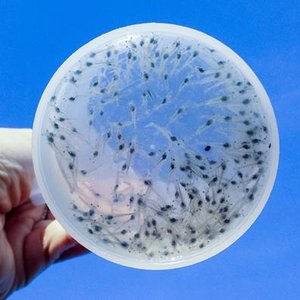Vietnam is one of the biggest producers of pangasius in the world, producing more than two million tons of pangasius feed that utilize more than 600,000 tons of soybean meal annually. Pangasius is primarily an export product and margins are very tight, so ensuring that targeted nutrition levels are maintained to efficiently produce a good product for the market is critical.
Since 2016, the U.S. Soybean Export Council (USSEC) has noted the potential of using U.S. soybean meal and targeting future development in Vietnam’s pangasius industry, and so USSEC has introduced the In-Pond Raceway System (IPRS) to Vietnam via trainings, visits to China IPRS models, and additional sharing of knowledge and experience. In FY20, USSEC identified the correct cooperator to start the first stage of this effort with pangasius in southern Vietnam with FFIC Pangasius Farm, in collaboration with the Missouri Soybean Association (MOSOY) through the Missouri Soybean Merchandising Council (MSMC).
USSEC is working with local Vietnamese farm and feed mill cooperators to create targeted U.S. soy-optimized feeds for a floating fingerling IPRS demonstration. The demo took place from March 17 – 31 at FFIC. If the demo indicates that this technology and quality of feed is worthwhile for producing advanced pangasius fingerlings, it could establish a new and more effective way to produce pangasius, helping to boost an important commercial aquaculture species. U.S. soy was purchased and used to produce feed for this floating IPRS demonstration.
Although the construction of the demonstration floating fingerling IPRS coincided with the COVID-19 pandemic, USSEC contractor Nguyen Thi Thuy Uyen (Trudy), who is responsible for this area, has been allowed to travel as the local situation still allows technical servicing (within strict guidelines). Ms. Nguyen has successfully steered the construction of the demo in virtual collaboration with other USSEC experts who are not able to visit the farm for face-to-face training. USSEC has provided online step-by-step training, every day during the construction time for the FFIC manager, farm staff, and construction team. It is estimated that IPRS will be launched later in April and that after a week, FFIC Farm will start to culture advanced pangasius fingerlings using U.S. soy-optimized diets, opening an opportunity not only for Vietnamese pangasius but also for U.S. soy.
It is estimated that the use of the floating IPRS system with high quality feeds for pangasius advanced fingerling production will result in a high survival rate of fish (greater than 80%). Once the fingerling issue is addressed, USSEC will be able to better make the case for improved feeds for grow-out as well.
USSEC’s work with aquaculture feed mills is the most critical part of the aquaculture team’s function as these feed mills are the end purchaser of U.S. soy products as an ingredient to incorporate into feeds. In this case, USSEC is able to showcase both a new technology (IPRS) as well as U.S. soy-optimized feeds.













